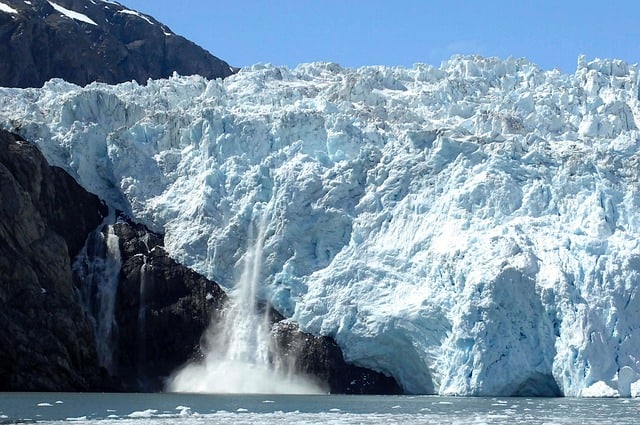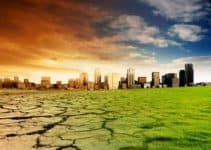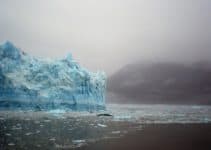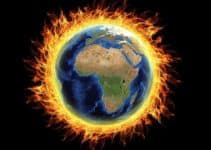The term ‘greenhouse gases’ (GHG) refers to a type of gas (and there are a few different gases that this can refer to) that is capable of holding or trapping heat in the atmosphere. In other words, greenhouse gases are the type of gases that first absorbs infrared radiation and then actually emit thermal radiation back. This whole process is basically what causes the greenhouse effect.
In the absence of the greenhouse effect, this planet would have been much colder and difficult for the human race to survive. An increase in the number of greenhouse gases in the atmosphere results in the greenhouse effect, which ultimately leads to global warming.
The planet Earth receives an enormous amount of sunlight from the sun. Of the total sunlight received, about 30% gets reflected back to space by clouds, ice, snow, sand and other reflective sources [NASA]. The remaining 70% of the solar radiation is absorbed by the oceans, the land, and the atmosphere. This is the reason that the earth remains warm even after the sun has gone down as it has absorbed a lot of energy from the sun.
During the night, the Earth’s surface cools down by giving off infrared radiation [EPA]. But before this radiation can emit back into space, they get absorbed by greenhouse gases in the atmosphere, which makes the atmosphere warmer. This is the reason why the earth remains warm, which makes it possible for humans to survive.
There are a number of different greenhouse gases, the primary ones of Earth being ozone (the layer that protects us and the rest of the world from the sun’s most harmful radiation), methane, carbon dioxide, and even water vapor. With all of these greenhouse gases in the Earth’s atmosphere, the Earth is actually, on average, approximately 33 degrees centigrade colder than it currently is, rendering most places uninhabitable.
Climate change is a global problem. The planet is warming because of the growing level of greenhouse gas emissions from human activity. If this trend continues, truly catastrophic consequences are likely to ensue from rising sea levels, to reduced water availability, to more heat waves and fires.
~ Malcolm Turnbull
What are the Sources of Greenhouse Gases?
As mentioned previously, there are a number of different greenhouse gases in the Earth’s atmosphere. The primary ones are Ozone, Methane, Water vapor, Carbon dioxide, and Nitrous oxide. These all have a number of different sources, and some of them are more common than others.
1. Ozone (O3)
The ozone layer protects the Earth from the most harmful of the sun’s rays and naturally occurs in the Earth’s atmosphere. The ozone layer occurs between 10 and 50 km above the Earth’s surface. Ozone is actually produced when the ultraviolet waves of the sun come into contact with oxygen molecules.
2. Methane (CH4)
Methane is often used as a fuel nowadays and is most commonly used for heating and cooking in homes. It occurs naturally in the Earth’s atmosphere and has also been created underground by the decomposition of organic materials over hundreds of millions of years.
It is one of the most commonly used fossil fuels, and in recent years we have been burning more and more of it, which has caused more and more of it to be pumped into the atmosphere as a greenhouse gas.
Additionally, and rather more comically, perhaps, methane is the main gas that is expelled from animals’ bodies when they fart. Unfortunately, because we now have so many cows on Earth for farming purposes, they are actually starting to seriously contribute to the level of methane in the atmosphere, which is contributing to global warming quite significantly.
3. Water Vapor (H2O)
Water vapor is simply the gaseous state of water and occurs naturally in the Earth’s atmosphere as a part of the water cycle. When water vapor collects as clouds in the sky, ready to rain, it can often lock in the heat because it is a greenhouse gas, which is why sometimes, even though it is rainy or grey and the sun cannot be seen, it can still feel warm or muggy.
4. Carbon dioxide (CO2)
Perhaps the most famous of all greenhouse gases, carbon dioxide, is absolutely essential to life here on Earth. It is the gas that we expel when we breathe out, and it is the gas that the trees and plants use as an essential component to photosynthesize.
Although it occurs naturally in the atmosphere, a combination of carbon and two oxygen atoms, the fact that we are burning many hundreds and thousands of tons of fossil fuels every single year is contributing greatly to the amount of carbon in the atmosphere. When fossil fuels such as coal are burned, they release carbon dioxide into the atmosphere.
Although it is perfectly safe in the atmosphere, too much of it is contributing to the number of greenhouse gases in the atmosphere, causing the average temperature of the Earth’s surface to rise gradually each year.
Basically, we are digging up coal, gas, and petroleum from the Earth’s crust, where it has remained for many millions of years and released that carbon dioxide back into the atmosphere, where it is causing problems such as the greenhouse effect.
5. Nitrous Oxide (N2O)
Nitrous oxide is more commonly known as ‘laughing gas’, and it is given to patients as a dissociated anesthetic. Once again, it is perfectly natural and is normally in the Earth’s atmosphere, although it constitutes only a very small percentage of the overall volume of gases.
Nitrous oxide creates nitric oxide when it reacts with oxygen atoms and so reacts with the ozone layer, making it one of the main regulators of the stratospheric layer of ozone around the Earth, as well as one of the main naturally occurring ones.
Effects of Greenhouse Gases on Climate Change
Greenhouse gases have had a huge effect on climate change. We have been pouring more and more carbon dioxide and methane into the atmosphere, which means that there are many more greenhouse gases present all around the world.
Because these gases allow the thermal radiation of the sun through and then reflect it back onto the surface of the Earth when it naturally rises again, it is causing the average temperature of the Earth’s surface to rise gradually.
1. Global Warming
Although the Earth has natural cycles of extreme heat and extreme cold, we are causing an unnaturally quick global warming with our constant burning of fossil fuels. More and more of the thermal radiation that comes to us from the sun millions of miles aware is getting trapped on Earth because of the dense layer of many different greenhouse gases, which means that the average temperature of the Earth is on the rise and not set to stop any time soon.
This means that many places are suffering from droughts more often throughout the year, and some places are becoming completely inhospitable.
2. The Melting of the Polar Ice Caps
As a direct result of the greenhouse gases keeping the heat from the sun close to Earth, the polar ice caps are starting to melt at an alarming rate. Not only is this problematic for the animals that rely on those ice caps for their survival – for instance, seals and polar bears that use them as shelter, places to hunt from and places to raise their young – but it could also mean that the average level of the sea will start to rise alarmingly quickly.
When the sea rises too high, it will start to cause some of the lower-lying land around the world to start disappearing, meaning that many thousands, if not millions of people, will be forced to move or may even die.
3. Changing of Climates and Seasons
Global warming is not all about the Earth slowly but surely getting hotter and hotter. In fact, it is a lot more complicated than that. Unfortunately, the accumulation of greenhouse gases in our atmosphere means that the average temperatures are gradually rising and that rain is becoming more and more scarce in some areas of the world, but it does also mean that seasons and climates are becoming more and more sporadic and difficult to predict.
It is also exacerbating precipitation extremes, making wet regions wetter and dry regions drier. For instance, places that are not usually rainy may start getting more and more rainfall; somewhere that usually does not see snow until deep into the winter may be surprised at snowfall in September, or perhaps even earlier. This is because the warming of the Earth has many knock-on effects that are difficult to track but that can cause disruption to the way that seasons and climates usually work.
4. Intensifying Extreme Weather Events
Greenhouse effects increase the intensity of extreme weather events, causing more frequent and/or intense extreme weather events, including heatwaves, hurricanes, droughts, and floods. The formation of hurricanes is connected with sea temperature that increases with the greenhouse effect.
5. Depletion of Ozone Layer
The ozone Layer found in the upper regions of the stratosphere protects the earth from harmful ultraviolet rays from the sun. The depletion of the ozone layer results in the entry of harmful UV rays to the earth’s surface that might lead to skin cancer and can also change the climate drastically. The accumulation of natural greenhouse gases, including chlorofluorocarbons, carbon dioxide, methane, etc. is behind this phenomenon.
6. Flooding of Islands and Coastal cities
Rising sea levels due to melting glaciers and sea ice and an increase in ocean temperatures (as warmer water expands) contribute to sea-level rise. According to IPCC, 2014, the global average sea level rose 19 centimeters during 1901-2010. It is estimated that the sea level will be 15-90 centimeters higher than now by 2100 and will threaten 92 million people.
7. Smog and Air Pollution
Smog is formed by the combination of smoke and fog caused by both natural means and man-made activities. Smog is generally formed by the accumulation of more greenhouse gases, including nitrogen and sulfur oxides. The major contributors that form smog are automobile and industrial emissions, agricultural fires, natural forest fires and the reaction of these chemicals among themselves.
8. Acidification of Water Bodies
An increase in the total amount of greenhouse gases in the air has turned most of the world’s water bodies acidic. The greenhouse gases mix with the rainwater and fall as acid rain leading to the acidification of water bodies. Also, the rainwater carries the contaminants along with it and falls into the river, streams and lakes, thereby causing their acidification.
9. Food shortages
As per the United Nations FAO, Climate change is raising questions regarding food availability due to decreased crop yields and decreased arable land availability (the coastal and river planes are often the most fertile soils), with subsequent starvation and malnutrition.
One-third of the world’s usable land has already severely degraded over the last 30 years, with 75 billion tons of soil from arable land lost annually, said UNCCD. It warns about food shortages because of the decline in agricultural production severely affecting Sub-Saharan Africa and South Asia.
10. Pandemics
Global warming due to the greenhouse effect is causing infectious diseases like malaria, cholera, dengue, recently COVID-19 to spread all over the world as per WHO. Additionally, extreme heat and pollution have also increased cardiovascular & respiratory problems.
11. Migration of species
According to the World Bank, climate change could force over 140 million to migrate within countries by 2050. Similarly, animal species will also be forced to migrate to survive the changes in the climatic pattern due to an increase in temperature.
That’s not all. It is also altering ecosystems and natural habitat, shifting the geographic ranges, seasonal activities, migration patterns, and abundance of land, freshwater, and marine species.
Sources:






